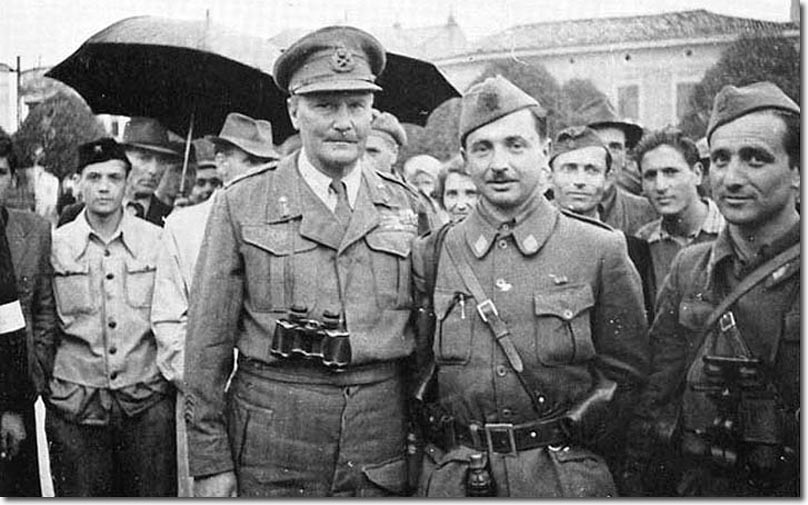|
|

 |
|
It was said of Bernard Freyberg that there wasn't a part of his body that did not have a scar. He was a very brave soldier who seemed to have no regard for danger and was always refusing to have his wounds dressed until the job was finished. Winston Churchill referred to him as the Salamander because he sought out the most dangerous places to be and survived.
Freyberg was born in Richmond Hill, Surrey on 21st Mar 1889 and was brought up in New Zealand from the age of 2 after his family moved there. He was a strong swimmer and in 1906 and 1910 he won the national 100 yards swimming championship. He qualified as a dentist in 1911 but left New Zealand in 1914 to go to San Francisco. He went to Mexico and became involved in the Revolution there. When war broke out in Europe he sailed to England and joined the RNVR. He was sent to the Dardanelles where he volunteered to swim ashore and light fires near the beach to distract the enemy from the landings at Gallipoli. This made him the first man to land in that theatre of war, and he received the DSO for it. In 1916 he transferred to the Army and entered the Queen's Royal West Surreys as a captain, but he was rapidly promoted so that by the time he won his VC he was commanding the battalion. The citation in the Gazette of 15th Dec 1916 describes the action: "On 13th Nov 1916 at Beaucourt sur Ancre, France, after carrying the initial attack through the enemy's front system of trenches, Lt-Col Freyberg's battalion was much disorganised, but after rallying and reforming his own men and some others, he led them on a successful assault of the second objective, during which he was twice wounded, but remained in command and held his ground throughout the day and the following night. When reinforced the next morning he attacked and captured a strongly fortified village, taking 500 prisoners. He was wounded twice more, the second time severely, but he refused to leave the line until he had issued final instructions." In all he was wounded 9 times in France. By April 1917 he was commanding a brigade in the 58th Division. At the age of 28 he was the youngest general officer in the army and had won another bar to his DSO and the Croix de Guerre, but in September 1917 he received his worst wound when a shell exploded near his feet. His war wounds caused him to have ill health after the war and a heart condition caused him to retire from the army in 1937. However, when war broke out in 1939 he was commanding the New Zealand Expeditionary Force and later the NZ 2nd Division. At the Battle of Crete he was in command of the Allied Forces. He led the New Zealanders through Greece, the North African Campaign, El Alamein and into Italy. At Monte Cassino he was involved in an error that is a stain on his career. The decision was made to bomb the ancient monastery after receiving intelligence that it was used by the Germans as an artillery observation post. This turned out to be wrong. On 15th Feb 1944 American bombers reduced this important historical and religious site to a ruin. In north Italy the 2nd New Zealand Division reached the city of Trieste where Yogoslav partisans had taken control. There were still German troops holding out but they were only prepared to surrender to General Freyberg. There was a tense stand-off between the New Zealanders and the Yugoslavs but Freyberg negotiated with them and agreed to let them take the German prisoners. The above photo shows an apprehensive Freyberg together with the partizan leaders. After the war, in 1946 Freyberg took up the post of Governor-General to New Zealand. He was the first person to hold the position who had grown up in the country. While there he visited all parts of the country and it's dependencies. The British Government, in 1951, created him Baron Freyberg of Wellington and Munstead in Surrey. The Freyberg High School in Palmerston North is a memorial to his Governorship and their Yearbook is called The Salamander in his honour. Lord Freyberg moved back to England when his tour of duty ended in 1952 and he was appointed Deputy Constable and Lieutenant Governor of Windsor Castle. He died there 10 years later on 4th July 1963 when one of his old war wounds ruptured. He was 74. His burial place is at St Martha's Hill, near Guildford in Surrey. There are memorials to him in the crypt of St Paul's Cathedral, St George's Chapel, Windsor, a bust of him in the Guildhall, London and a statue in New Zealand. |
New Zealand | New Zealand Administrators
Armed Forces | Art and Culture | Articles | Biographies | Colonies | Discussion | Glossary | Home | Library | Links | Map Room | Sources and Media | Science and Technology | Search | Student Zone | Timelines | TV & Film | Wargames